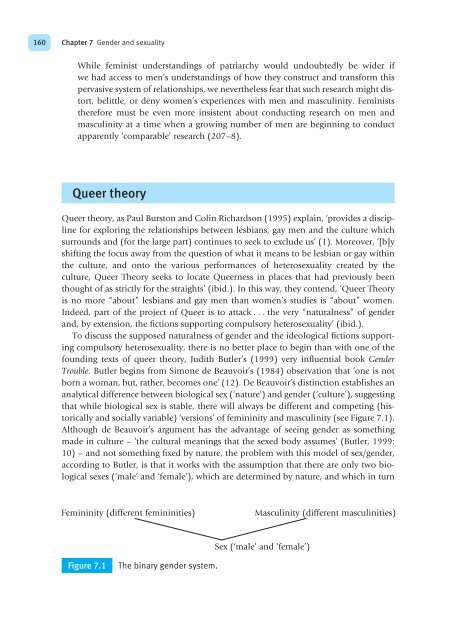Cultural Theory and Popular Culture
Cultural Theory and Popular Culture
Cultural Theory and Popular Culture
You also want an ePaper? Increase the reach of your titles
YUMPU automatically turns print PDFs into web optimized ePapers that Google loves.
160<br />
Chapter 7 Gender <strong>and</strong> sexuality<br />
While feminist underst<strong>and</strong>ings of patriarchy would undoubtedly be wider if<br />
we had access to men’s underst<strong>and</strong>ings of how they construct <strong>and</strong> transform this<br />
pervasive system of relationships, we nevertheless fear that such research might distort,<br />
belittle, or deny women’s experiences with men <strong>and</strong> masculinity. Feminists<br />
therefore must be even more insistent about conducting research on men <strong>and</strong><br />
masculinity at a time when a growing number of men are beginning to conduct<br />
apparently ‘comparable’ research (207–8).<br />
Queer theory<br />
Queer theory, as Paul Burston <strong>and</strong> Colin Richardson (1995) explain, ‘provides a discipline<br />
for exploring the relationships between lesbians, gay men <strong>and</strong> the culture which<br />
surrounds <strong>and</strong> (for the large part) continues to seek to exclude us’ (1). Moreover, ‘[b]y<br />
shifting the focus away from the question of what it means to be lesbian or gay within<br />
the culture, <strong>and</strong> onto the various performances of heterosexuality created by the<br />
culture, Queer <strong>Theory</strong> seeks to locate Queerness in places that had previously been<br />
thought of as strictly for the straights’ (ibid.). In this way, they contend, ‘Queer <strong>Theory</strong><br />
is no more “about” lesbians <strong>and</strong> gay men than women’s studies is “about” women.<br />
Indeed, part of the project of Queer is to attack . . . the very “naturalness” of gender<br />
<strong>and</strong>, by extension, the fictions supporting compulsory heterosexuality’ (ibid.).<br />
To discuss the supposed naturalness of gender <strong>and</strong> the ideological fictions supporting<br />
compulsory heterosexuality, there is no better place to begin than with one of the<br />
founding texts of queer theory, Judith Butler’s (1999) very influential book Gender<br />
Trouble. Butler begins from Simone de Beauvoir’s (1984) observation that ‘one is not<br />
born a woman, but, rather, becomes one’ (12). De Beauvoir’s distinction establishes an<br />
analytical difference between biological sex (‘nature’) <strong>and</strong> gender (‘culture’), suggesting<br />
that while biological sex is stable, there will always be different <strong>and</strong> competing (historically<br />
<strong>and</strong> socially variable) ‘versions’ of femininity <strong>and</strong> masculinity (see Figure 7.1).<br />
Although de Beauvoir’s argument has the advantage of seeing gender as something<br />
made in culture – ‘the cultural meanings that the sexed body assumes’ (Butler, 1999:<br />
10) – <strong>and</strong> not something fixed by nature, the problem with this model of sex/gender,<br />
according to Butler, is that it works with the assumption that there are only two biological<br />
sexes (‘male’ <strong>and</strong> ‘female’), which are determined by nature, <strong>and</strong> which in turn<br />
Figure 7.1 The binary gender system.
















